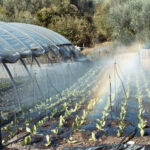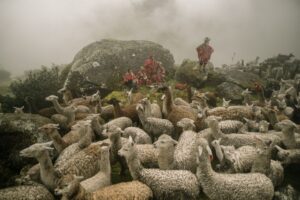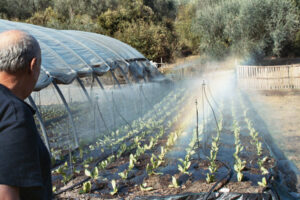Raposa-Serra do Sol, in the State of Roraima, in the north of Brazil, is a network of biomes locally known as lavrado. In this region, the lavrado encompass grasslands, steppe savannas, shrubs and patches of small forest, which are part of a delicate interconnected network of ecosystems that nourish and support what is often referred to as the Amazon. These ecosystems are sustained by a mostly humid climate, with two clear seasons: the wet from April to November; and the dry from December to March. During the wet months, seasonal lakes appear that connect to larger rivers, watercourses that act as barriers against fire. In dry years, during El Niño events, these once watery channels become corridors of fire.
Lavrados are largely protected in Brazil due to the demarcation of Indigenous territories — which encompass more than 46 percent of Roraima State — including Raposa-Serra do Sol, the Land of the Fox and Mountain of the Sun, which covers more than 1.7 million hectares. Raposa-Serra do Sol was signed into Brazilian law by President Luis Inácio Lula da Silva on April 15 2005. The land is along the border with Venezuela and Guyana, and is the home to approximately 58,000 inhabitants from nine different Indigenous communities: Macuxi, Wapichana, Taurepang, Ingarikó, Wai-Wai, Yanomami, Ye’kuana, Patamona, and Sapará. The way of life of these communities is focused on their environment, where they hunt, farm and fish.

The demarcation process emerged through community discussions in 1983, which developed into the Assemblies of Tuxauas and led to the formation of the Conselho Indígena de Roraima (Indigenous Council of Roraima, the CIR) in 1990. The CIR brought together people from Ingarikó, Macuxi, Patamona, Sapará, Taurepang, Wai-Wai, Wapichana, Yanomami and Ye’kuana communities, who advocated for their collective and respective sovereignty. For the first two decades of operations, the CIR focused on the struggle for demarcation of the lands of the Ingaricó, Macuxi, Patamona, Tuarepang and Wapichana peoples, which spans nearly half of Roraima, and is one the highest areas of conservation of any State in the Brazilian Amazon.
While this is a story of the symbiotic relationship between the Indigenous Peoples and their land, it is also a story of the way this land, and how land more generally, is perceived through an economic and political lens by both the Brazilian and international community.
Raposa-Serra do Sol is rich in biodiversity — and cultural significance to the people who have long called it home — and abundant in so called natural resources: deposits of gold, diamond, titanium, amethyst, kaolin, zinc, copper, niobium, cassiterite, crystal, diatomite, barite, molybdenum, niobium, limestone, mineral water and possibly, although not confirmed, oil.
The long resistance of the Indigenous Peoples of Raposa-Serra do Sol is exemplified by the well-documented interest in the neighbouring Yanomami territory by opportunistic miners.
The invasion of miners through Yanomami territory began after the fall of Brazil’s lengthy military dictatorship. The Federal Government of the dictatorship had encouraged the belief that the Amazon will bring economic development to Brazil. Advertising in 1972 claimed that the Amazon is where “land is cheap and your farm can have all the pasture your cattle need.” This claim was aided by tax incentives and financing to support those seeking this proposed opportunity.
Propelled by the discovery of gold at the base of Serra Pelada, in the State of Pará, a mining rush swept through the north of Brazil into Yanomami territory. Fuelled by personal ambition, miners were emboldened by the belief that Brazilian society would be strengthened by the extraction of the natural resources supposedly offered by the Amazon rain forest. 40,000 miners sought gold and cassiterite in Yanomami territory, viewing the Yanomami people as obstacles to overcome along the path toward fortune.

In the town of Saúde, in the State of Bahia, a young Lieutenant in the Brazilian Army, Jair Bolsonaro, prospected for gold while on holiday during his active service. His superiors received word of this holiday — which he enjoyed with three lieutenants and two paratrooper sergeants — leading to an internal evaluation that labelled the young Bolsonaro as having “excessive ambition”. This may have been true — Bolsonaro’s ambition was evident when he left the army to begin his long political career — but it also reflected the view that mining equated to wealth, both personal and collective, which was encouraged by the Brazilian government and was gaining more popularity in Brazilian society. A 1987 survey by Brazilian anthropologists found that 30 percent of Indigenous territories had experienced entry by independent miners and 70 percent by mining companies.
As miners established themselves on Yanomami territory, more and more violence was directed toward Yanomami people, leading to the death of around twenty percent of their population over seven years. Yanomami spiritual and political leader Davi Kopenawa, along with Survival International and the Comissão Pró-Yanomami (CCPY), led an international campaign for the demarcation and protection of Yanomami territory through the Interministerial Decree nº 160 on September 13 1988, which declared 8,216,925 hectares of land as the permanent possession of the Yanomami People.
The Decree was issued in the lead-up to the ratification of the new Constitution of the Federative Republic of Brazil, which guaranteed the Rights of Indigenous Peoples by articulating the legitimacy of the Brazilian State to legislate over them. This was achieved through Chapter VIII, and specifically Article 231, which defines Indigenous territory as land “traditionally occupied…which they live on a permanent basis…used for their productive activities, those indispensable to the preservation of the environmental resources necessary for their well-being and for their physical and cultural reproduction, according to their uses, customs and traditions”. Article 231 articulated the Brazilian State will demarcate, protect and ensure respect for Indigenous territories; that Indigenous Peoples will have exclusive use of the resources emanating from the soil, rivers and lakes existing within their territories; that the minerals below their territories can only be prospected and mined with the authorisation of the National Congress; that the removal of Indigenous Peoples from their land is forbidden except by the National Congress (in case of a catastrophe, an epidemic or in the interest of the sovereignty of Brazil); and any act with a view to occupation, domain or possession of their lands is “null and void”, unless it was accomplished with “relevant public interest” of the Brazilian State and through a supplementary law. Article 232 gave the Indigenous Peoples of Brazil the right to sue to defend their rights and interests.
The Yanomami’s submission of Decree nº 160, with support of the Rights contained within the new Constitution, inspired a long process that involved significant opposition, which included Members of Congress from Roraima filing a lawsuit against the process, and the Governor of the State of Amazonas threatening to send state police to shoot any Fondazione Nazionale dell’Indio (FUNAI) agent trying to demarcate the territory. Jair Bolsonaro, now the Federal Deputy for Rio de Janeiro, asked the Federal Congress, “that area is the richest in the country, why set up an indigenous reserve there?” He also claimed the Yanomami were a threat to national security and could start a separatist movement. This echoed the words of Sertanista Orlando Villas-Bôas, who, in the 1970s, articulated the belief that the creation of Indigenous reserves in border areas were a risk to the integrity of the Brazilian territory and that missionaries had the covert goal of establishing independent or semi-independent bodies that would fragment the Brazilian Government’s control of the Amazon. Despite these objections, the Decree nº 160 was finally passed into Brazilian law in 1992 and the many miners operating in Yanomami Territory were temporarily expelled.
Throughout this period, the Indigenous Peoples of Raposa-Serra do Sol were also struggling with the incursions of miners, as well as those of cattle breeders, rice producers and the Brazilian Army — who built barracks in the area and carried out training procedures near the border with Guyana. Indigenous land was stolen or destroyed, and many Indigenous Peoples suffered through physical attacks. These tensions were partly inspired by the advancement of the demarcation process of Raposa-Serra do Sol, through mapping conducted by FUNAI and the ratification of the territory by President Lula da Silva through Decree 534/2005, which led to the Federal Government trying to remove the remaining non-Indigenous occupants, who resisted, burning bridges and attacking community centres, leading to violent confrontations that culminated in the shooting of ten Indigenous people on May 5 2008.

As this process was conducted by Federal bodies, the State Government of Roraima, encouraged by local landowners reluctant to relinquish control of these lands, attempted to stop the demarcation of Raposa-Serra do Sol. The State Government filed an injunction alleging “FUNAI has promoted the compensation and removal of the non-indigenous settlers since 2002.” The injunction articulates the process of removal, and the subsequent compensation for the “non-Indigenous settlers”, and how “a group of 40 to 50 families, under the leadership of 8 large-scale rice growing business owners, do not accept the government’s offers and refuse to leave the location.” The injunction meant that the settlers could not be removed until legal actions dealing with the demarcation of Raposa-Serra do Sol were resolved, which required the intervention of the Brazilian Supreme Court, who initially set August 27 2008 as the date of its ruling.
The first and only judge to vote on August 27, Carlos Ayres Britto, voted in favour of the demarcation, stating the Indigenous Peoples of Raposa-Serra do Sol are the original and continuous occupants of the territory, and the area of land outlined by FUNAI needed to be maintained to ensure these communities could maintain their way of life. The ruling was then postponed after one of the justices, Carlos Alberto Menezes Direito, asked for more time to further examine the case. The second session of the judgement occurred on December 10, with another seven justices voting in favour of Raposa-Serra do Sol, until Minster Marco Aurélio de Mello requested to review the case further. Finally, on March 19 2009, the Supreme Court confirmed the validity of Raposa-Serra do Sol, with 10 justices voting in favour and only Minister de Mello voting against.
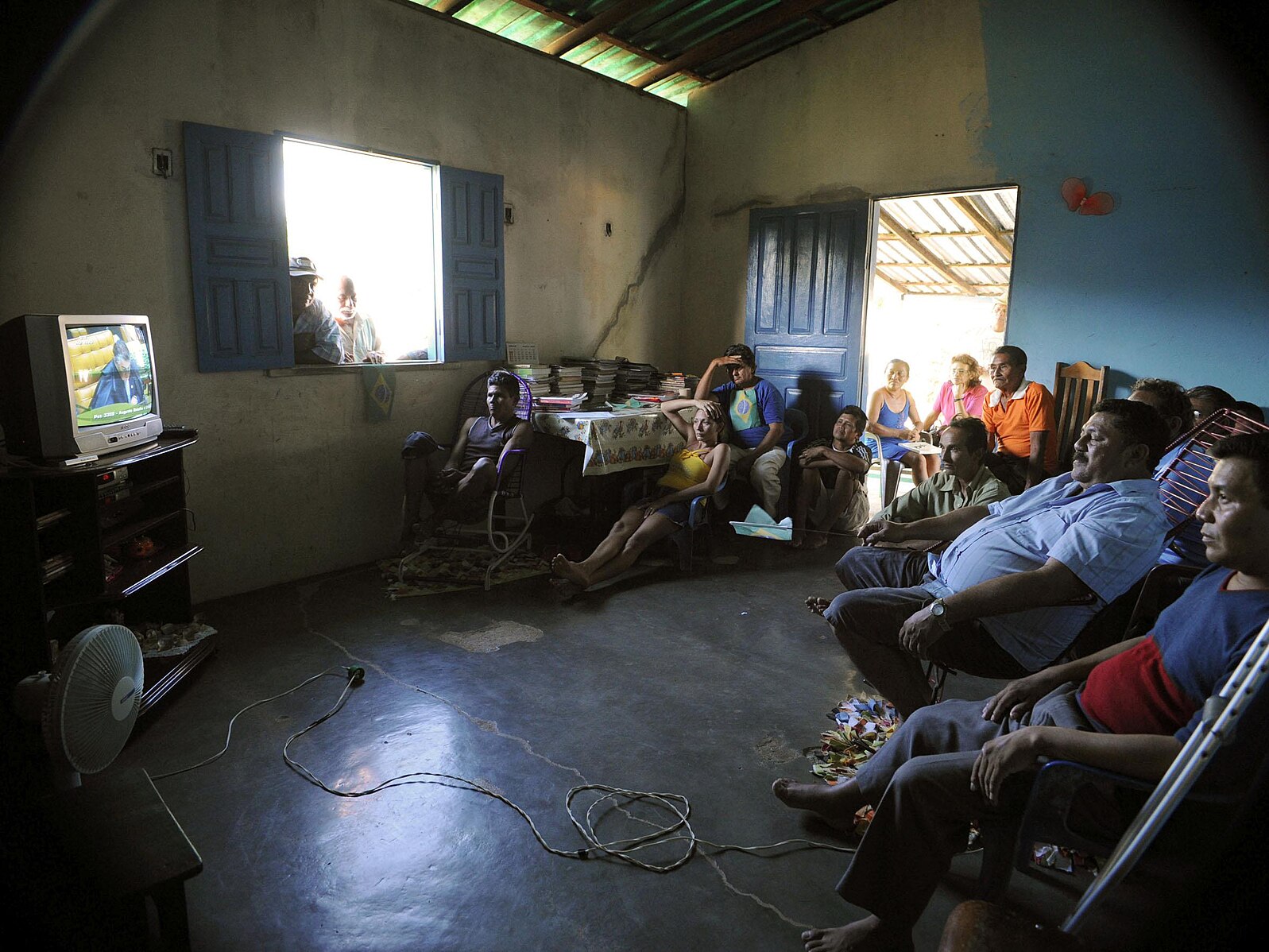
The judgement was given with 19 conditions, called “institutional safeguards“, which gave Brazilian states the right to be involved in demarcation processes, and could affect the way Indigenous territories would be approved in the future. Among the 19 conditions of the Raposa-Serra do Sol judgement was the first legal articulation of the Temporal Framework, often referred to as the “time frame”, or Marco Temporal.
The discussion of Marco Temporal relates to Indigenous Rights to land, as referenced within the Constitution, and specifically the land they “traditionally occupy”. Throughout the case there was significant discussion around the timeless connection between Indigenous Peoples and the land that defines their being, and how the land and Indigenous Peoples are interconnected. Yet as the case arose from the tensions between the different perceptions of the disputed territory — of the Indigenous Peoples, rice producers, farmers and miners, as well as the State and Federal Governments — a specific articulation of the Rights of Indigenous Peoples, and the laws that uphold them, was necessary. For the sake of specificity, I quote from the judgement (albeit a translation of the judgement) and the words of Minister Carlos Alberto Menezes Direito:
“In the first place, indigenous lands are lands occupied by Indians. They are not lands that they occupied in times gone by and no longer occupy; they are not lands that they occupied up to a certain date and no longer occupy. They are lands occupied by the Indians when the 1988 Constitution was promulgated.
“The landmark for determining indigenous occupation (5/10/1988) derives from the very constitutional system of protecting the rights of Indians, which could not fail to cover all the indigenous lands existing when the Constitution was promulgated, under penalty of giving rise to the unlawful dispossession of Indians by non-Indians after it came into force. This even occurred after the 1946 Constitution, even though it guaranteed their right over their lands… The correct extension of the protection initiated by the 1988 Constitution requires, therefore, that the presence of Indians be verified on the date of its promulgation… Occupation is, therefore, a fact to be verified.
“Secondly, indigenous lands are lands traditionally occupied by Indians. For José Afonso da Silva, so often cited in this process, contrary to what prevailed in previous Constitutions, the adverb ‘traditionally’ should not be understood as referring to an occupation since more than prehistoric times, an immemorial occupation:
“‘Traditionally occupied lands’ does not reveal a temporal relationship. If we refer to the Charter of 1 April 1680, which recognised that the Indians had the land where they are just like the land they occupied in the hinterland, we will see that the expression traditionally occupied does not mean immemorial occupation. It does not mean, therefore, lands immemorially occupied, i.e. lands that they would have been occupying since remote times that have already been lost to memory and, thus, only these would be their lands’.
“The concept indicates mode of occupation, the way in which the Indians relate to the land. It is a new angle on the previous Constitutions which, if on the one hand justifies the geographical extension of the rights to be recognised, on the other hand may mean the requirement that occupation by the Indians must be in accordance with the culture and ‘modus vivendi’ which it is wished to preserve…
“‘Lands which Indians traditionally occupy’ are, of course, lands which the Indians have occupied for some time at the time of the promulgation of the Constitution. It is a question of both a constant presence and persistence on these lands. Lands that are eventually abandoned do not lend themselves to classification as indigenous lands, as already stated in Precedent no. 650 of this Federal Supreme Court. A well-defined presence in space over a certain period of time and a persistence of that presence, which makes permanent habitation another fact to be verified…
“I propose, therefore, that we adopt as the constitutional criterion not the theory of indigenato, but that of the indigenous fact. The assessment of the indigenous fact on 5th October 1988 involves a choice that gives prestige to legal security and avoids the practical difficulties of an immemorial investigation of indigenous occupation. But permanent dwelling is not the only parameter to be used in the identification of indigenous lands. In truth, it is the parameter for identifying the base or nucleus of occupation of indigenous lands, from which the other expressions of that occupation must manifest themselves.”
These words are what people refer to as the Marco Temporal thesis. It is a shift from the indigenato theory — the belief that the Rights of Indigenous Peoples predate the conception of the Brazilian State — to “indigenous fact” — fixing the date of occupation to the Constitution — an attempt to create clarity between the different perceptions of the demarcation of Indigenous territories in Brazil. Minister Gilmar Mendes described the judgement and its conditions:
“We fixed a true statute that should be applied not only to the case of Raposa-Serra do Sol, but also to the other demarcation processes, including ongoing processes. The court established, for example, that areas already demarcated will no longer be subject to revision, whether after or before the Constitution. With this, we put an end to a large number of controversies and some expansionist impulses”.

The judgement led to the demarcation of Raposa-Serra do Sol and the eviction of the non-Indigenous occupants. While a decision by the Supreme Court does not define future decisions, they are commonly used to frame similar cases, and after the initial relief of Raposa-Serra do Sol finally being demarcated, fears emerged with how the 19 conditions would influence the Rights of Indigenous Peoples across Brazil. In a letter addressed to the United Nations Committee on the Elimination of Racial Discrimination, the peoples of Raposa-Serra do Sol, along with the Indigenous Council of Roraima, expressed their “concern” with the Supreme Court’s judgement:
“The Supreme Court did not confine itself to endorsing the Raposa demarcation, but it went further to interpret and define – if not ‘redefine’ – the rights of indigenous peoples as currently affirmed in Article 231 of the Brazilian federal Constitution. Among other things, the Supreme Court placed numerous limitations on the rights of indigenous peoples to their property. In many ways those rights are now unrecognizable when compared to their growing meaning and application under Brazilian law”.
In the “Special Report on the Situation of Human Rights of Indigenous Peoples in Brazil“, James Anaya, the Special Rapporteur on the Rights of Indigenous Peoples, provided the UN’s perspective on the situation:
“Article 27 of the United Nations Declaration affirms the right of indigenous peoples to ‘own, use, develop and control the lands, territories and resources’ they traditionally occupy; for its part, ILO Convention 169 declares in its article 14, ‘The rights of ownership and possession of the peoples concerned over the lands which they traditionally occupy shall be recognized.’ In light of these international standards, to which Brazil has committed, indigenous peoples must effectively enjoy rights over their lands that are the equivalent of ownership, and the State’s property interest in indigenous lands must operate only as a means of protection and not as a means of interference with indigenous control. Additionally, both under the Declaration (arts. 19, 30, 32) and ILO Convention 169 (arts. 6, 15.2), indigenous peoples have the right to be consulted on any decision affecting them with the objective of achieving their agreement or consent, including with regard to the exploitation of subsurface resources owned by the State or the establishment of military installations. Whatever the validity or ultimate disposition of the 19 conditions articulated by the Supreme Federal Tribunal, administrative, legislative and military authorities should exercise their powers in relation to indigenous lands in a manner consistent with these international norms. Further, the enactment of domestic legislation or administrative regulations to implement these standards is desirable.”
Through this period, discussion around the Belo Monte Hydroelectric Power Plant had reignited. Initially proposed in 1970s, the Plant was to be built in the state of Pará on the Xingu River, and after more than 40 years of the mappings, and considerable backlash from Indigenous Peoples and NGOs, an 18-member consortium called Norte Energia — comprising government-owned Eletrobrás and a handful of state pension and private investment funds — won an auction in 2010 to begin construction. The Federal Court suspended the licence citing concerns of “irreparable damage” to the environment and the belief the project was unconstitutional — specifically relating to Article 176 of the Federal Constitution and that the proposed dam was to be built on Indigenous territories. Discussions moved between the Brazilian Institute of Environment and Renewable Natural Resources (IBAMA), FUNAI, the representative bodies of the many affected Indigenous communities and the Brazilian Government, until President Lula da Silva signed a contract with Norte Energia on 26 August 2010. The Brazilian Government believed the project would maintain economic growth and would lift a proportion of the population from poverty, which relates to Article 231 of the Constitution and the Brazilian Government’s ability to possess Indigenous territory if done with “relevant public interest”.
A federal court in Pará, suspended the commencement of construction as environmental requirements for the project had not been met. This was then overturned by Olindo Menezes, the President of the Federal Regional Court in Brasilia, a higher court than the one in Pará. Construction finally began but was quickly suspended, through a ruling by yet another judge, which was then overturned by the Supreme Court. Belo Monte was then constructed and directly impacted the Arara, Arawaté, Assurini, Curuaya, Juruna, Kayapó, Parakanã, Xicrin and Xipaya people. For the Arara and Juruna peoples of the Volta Grande do Xingu, the impacts were great, with almost 80% of the Xingu River in their lands diverted, completely transforming their territory while simultaneously affecting their economy, politics and culture.

In the background of this process, the Marco Temporal debate continued. Six requests for clarification of the Raposa-Serra do Sol decisions were made, which led the Attorney General of Brazil, through Ordinance 303, to state the conditions were mandatory for all processes of demarcation of Indigenous territories. Protests ensued throughout Brazil and the National Commission for Indigenous Policy (CNPI) asked the Brazilian Government to revoke the Attorney General’s Ordinance. This led to another trial in the Supreme Court, with the justices ruling that the Raposa-Serra do Sol decisions are “not binding on judges and courts when examining other cases relating to different indigenous lands” and the Raposa-Serra do Sol judgement “applies only to the land in question”. Despite this decision, the Attorney General reissued Ordinance 303. The Raposa-Serra do Sol case was then referenced in judgements on the Guyraroká, Limão Verde and Porquinhos territories, which were suspended or annulled.
These rulings, and the tension of the contrasting positions of the Attorney General and the Supreme Court, created greater ambiguity in the demarcation of Indigenous territories, which inspired the Government of President Michel Temer, in July 2017, to publish an official opinion on the matter, emphasising the Marco Temporal thesis, which Temer considered as “binding“. The Attorney General at the time, Grace Mendonça, offered her perspective:
“This opinion, now binding on the federal public administration, pays tribute to the guidelines established by the STF in the Raposa-Serra do Sol demarcation process, provides greater legal security and is aligned with an effort by the AGU to promote a reduction in litigation”.
FUNAI immediately reevaluated demarcation processes of Indigenous territories throughout Brazil, including those already submitted to the Ministry of Justice for approval. This was followed by the election of Jair Bolsonaro as President, who followed through with his campaign promise to not demarcate any new Indigenous territories. Bolsonaro, a champion of agribusiness and mining, actively pursued policies that threatened the Rights and lives of Indigenous Peoples, which led to current President Lula da Silva accusing his predecessor of “genocide” against Brazil’s Indigenous communities, particularly the Yanomami.
Despite all of these judgements and decisions, the debate surrounding Marco Temporal remains unresolved. This is due to an appeal by FUNAI to the Supreme Court in 2016 against the Foundation for Technological Support to the Environment (FATMA) in Santa Catarina, who previously filed an action for the repossession of the Ibirama-Laklãnõ Indigenous Territory in the State of Santa Catarina in 2009. This appeal had a “general repercussion” unanimously recognised by the Supreme Court on April 11 2019, meaning the judgement of this case — referred to as Extraordinary Appeal 1,017,365 — will act as a precedent for all cases involving the demarcation of Indigenous territories at all levels of the Brazilian judicial system.
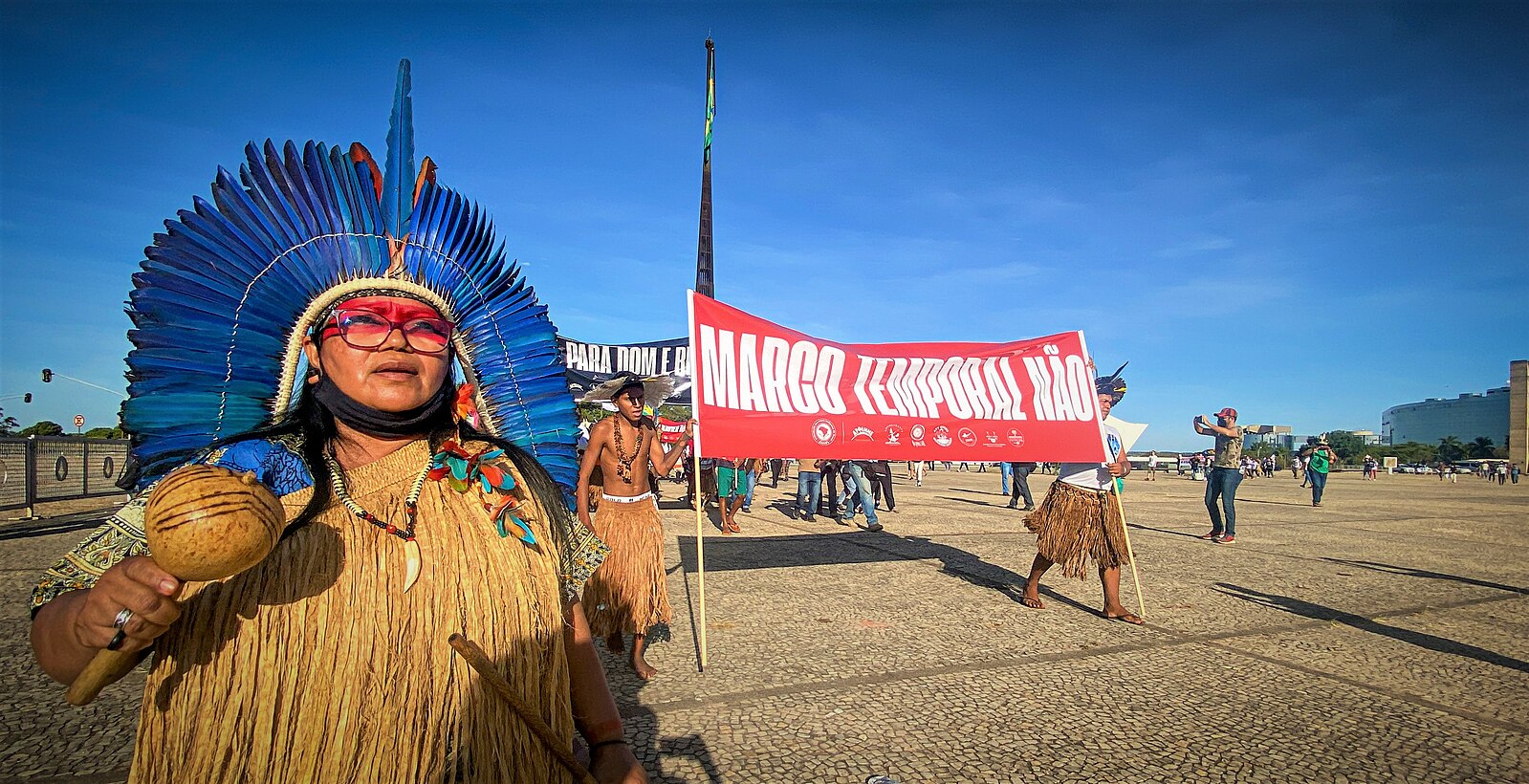
The development of this case, and its ongoing delays, occurred alongside the progression of Bill (PL) 490/2007. The Bill, filed by the Federal Deputy of Mato Grasso Homero Pereira in 2007, has since received 13 additional points and has been archived and unarchived three times. PL 490 was approved on June 23 2021 by the Constitution and Justice Committee and moved into the Chamber of Deputies, the lower house of the Federal Congress. The Articulation of Indigenous Peoples of Brazil (APIB) wrote a technical note summarising the intentions of PL 490:
“i) transfer the competence for the demarcation of Indigenous Lands from the Executive Power to the Legislative Power; ii) transform into Law the thesis of the temporal landmark, with the objective of making the demarcation of Indigenous Lands unviable; iii) allow the construction of highways, hydroelectric plants and other construction sites inside Indigenous Lands, without free, prior and informed consultation with the affected communities; iv) mitigate the difference between traditional indigenous land possession as stated in the Federal Constitution and private land possession under civil law, foreseeing that farmers may sign contracts with indigenous people to plant soybeans, raise cattle and even illegal gold-digging and mining sites, which violates the rights of Indigenous Peoples’ to the exclusive usufruct of demarcated lands and weakens the protection and demarcation of Indigenous Lands; v) authorize any person to question demarcation procedures in all phases of the process, including those already approved, causing legal insecurity; vi) recognize the legitimacy of titles, possessions, and domains taking place over areas of traditional occupation, as a means of favouring land grabbing; vii) revive dictatorial paradigms in the Brazilian legal system that were overcome by the Federal Constitution of 1988, such as the tutelary regime and assimilationism, which seek to acculturate Indigenous Peoples (within national standards), denying them the Right to Identity; viii) disregard and disrespect indigenous policy of non-contact with Indigenous Peoples in a situation of voluntary isolation by making it more flexible; ix) reformulate fundamental constitutional concepts of indigenous policy, such as the traditional nature of occupation, the original right and exclusive usufruct.”
The political process of PL 490 is connected to the legislative process of Marco Temporal, as both seek to change the legal interpretation of the Constitution, specifically the rules for demarcating Indigenous territories. The Bill’s reintroduction meant there were simultaneous processes focused on Indigenous territories in the legislative and political systems of Brazil.
On September 9 2021, the Federal Supreme Court began its judgement of Extraordinary Appeal 1,017,365. Minister Edson Fachin, Rapporteur of the process, voted against Marco Temporal and the definition of the Raposa-Serra do Sol judgement, and its conditions, as precedent for future demarcations of Indigenous territories. He offered his perspective when lodging his vote:
“It is necessary to recognise that the decision taken in Petition nº 3,388 (the Raposa-Serra do Sol case), far from achieving the desired pacification, brought about a real paralysis in the demarcation of indigenous lands in the country…with an intensification of conflicts and a significant worsening in the quality of life of Indians in Brazil… To say that Raposa-Serra do Sol is a precedent for the entire indigenous question is to make other indigenous ethnic groups unviable. It is to say that the solution given to the Macuxi is the same as that given to the Guarani. For the Xokleng, it would be the same for the Pataxó. Only those who, with all due respect, call everyone ‘Indian’ forget the more than 270 languages that make up Brazilian culture. And only he who pacifies the different and distinct ethnic groups can say that the solution must always be the same. Whoever does not see the difference does not promote equality.”

The case adjourned for a week, recommencing on September 15 2021. That morning, President Jair Bolsonaro offered his thoughts, “if this new time limit comes into existence, should the Supreme Court decide so, it will be a hard blow to our agribusiness, with almost catastrophic internal repercussions, but also abroad.” Hours later, Minister Nunes Marques voted in favour of Marco Temporal:
“It is necessary to bear in mind that the wording of the constitutional text clearly points in the direction that indigenous possession should exist in the year 1988, in traditional character. Possessions after 1988 cannot be considered traditional because this would imply not only recognition of indigenous rights to their lands, but also the right to unlimited expansion to new areas already definitively incorporated into the national real estate market.”
He felt that the Raposa-Serra do Sol judgement and conditions provided necessary clarity that should help settle future demarcations. Minister Alexandre de Moraes was next to vote and asked to see the case records, once again delaying the process.
In April this year, Supreme Court Justice Rosa Weber announced that the vote would resume on June 7. The Chamber of Deputies decision on PL 490 was also delayed, finally being approved on May 24, which led to a vote in the Federal Congress on May 30, with the Bill passing 283 votes to 155. The Bill thus enters into the Senate, where it has been given a new number, now known as PL 2903. On June 7 in the Supreme Court, Justice Alexandre de Moraes voted against the Marco Temporal thesis before proceedings were again halted, this time by Justice André Mendonça, who requested more time to analyse the case.
When casting his vote, Justice Alexandre de Moraes proposed alternative approaches to conflict caused by future demarcations. The first suggestion relates to what he called “prior indemnification“, where the Brazilian Government would compensate landowners of land traditionally occupied by Indigenous Peoples — only if there’s no evidence of illegal land seizure, physical conflict or legal disputes — on the date the Constitution was enacted. The second relates to the compensation of territories seized “in the public interest”, where the Brazilian Government would offer Indigenous Peoples an alternative territory to the one they intended to demarcate. Mauricio Terena, a legal coordinator for APIB believes this proposal does not support Indigenous Peoples, disconnecting them from their territory while potentially exacerbating current conflicts.
In response to the crisis created by the simultaneous votes in the Senate and the Supreme Court, the UN’s Special Rapporteur on the Rights of Indigenous Peoples, José Francisco Calí Tzay, issued a statement condemning the Marco Temporal thesis and urging both the Supreme Court and the Federal Senate, as well as the Brazilian Government, “to guarantee historic reparations for Indigenous Peoples and prevent the perpetuation of further injustices.“
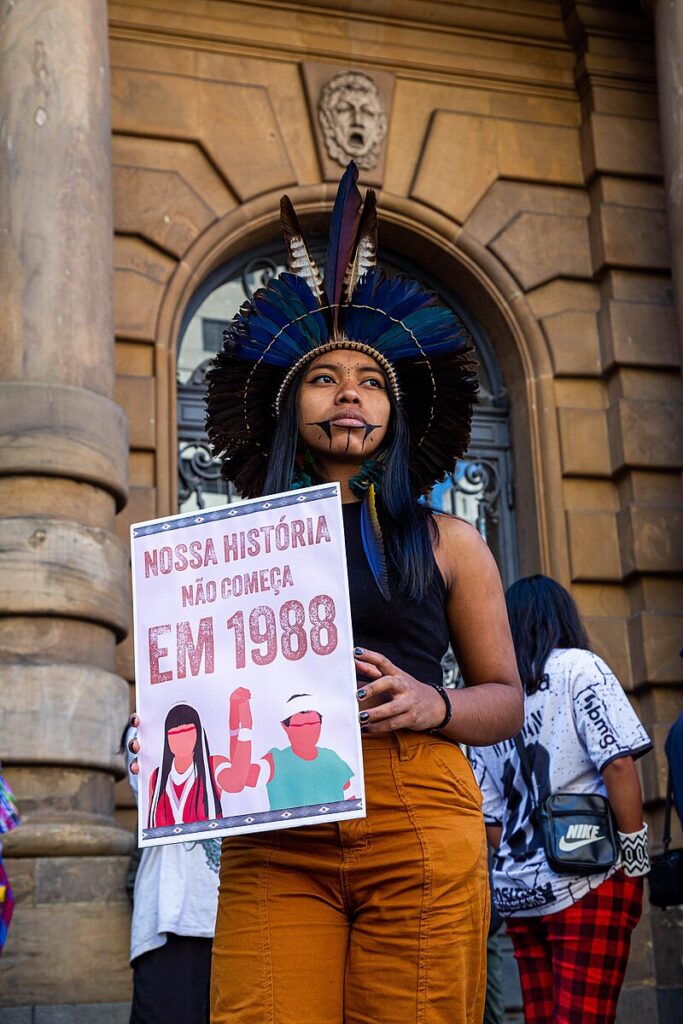
It is here that the situation surrounding Marco Temporal currently stands. This has been a long process where lives have been lost and even more threatened. It has led to devastation on a personal, cultural and environmental level.
While this article has largely focused on dates, bills and judgements, this reflects the reality of the situation, where the lives of individuals and communities, and the natural environment they nurture and protect — which sustains the entirety of life on our planet — has been reduced to a particular date and the political and legal arguments that support it.
This is a story of sovereignty, a concept dating back to 1648 and the conclusion of the Thirty Years’ War in Europe, and two treaties collectively known as the Peace of Westphalia. These treaties birthed the defining principle of the international nation state system that each state has exclusive rule over its determined territory. The specific parameters of the sovereignty of modern Brazil dates back to the Treaty of Tordesillas, an agreement between Portugal and Spain, Empires that stem from the Holy Roman Empire, which believes sovereignty comes from above, through divine right and the belief in a Catholic God. This belief was imposed on the Indigenous Peoples of Brazil, despite their own traditions of sovereignty and spirituality, traditions that Article 231 of the Brazilian Constitution acknowledge and supposedly protect. While we are now speaking in terms of politics, bureaucracy and law, when we trace the roots of this system of thought and action, we are still discussing the different worldviews and the different conceptions of sovereignty for the Indigenous Peoples of Brazil and the settlers who call that territory home.
eco-nnect has been a proud part of an informal alliance of individuals and groups who have come together to support the situation in Brazil. The focus of this alliance has been a petition and a social media campaign to put pressure on the President of Brazil’s Federal Senate, Rodrigo Pacheco — who has the ability to block PL 2903 — while also reminding the Representatives of the Federal Senate and the Justices of the Supreme Court of the responsibility they currently hold. The situation is ongoing, so please support the Indigenous Peoples of Brazil; their important and inherent relationship with their territories; and the legal recognition of their sovereignty.
Anton Rivette is a writer and photographer. He leads storytelling at eco-nnect.




